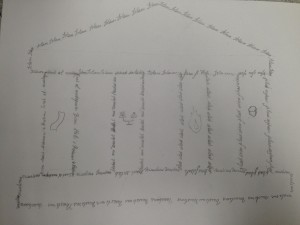
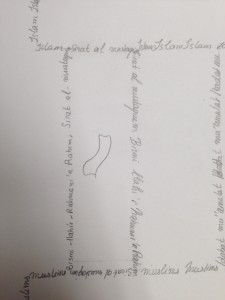
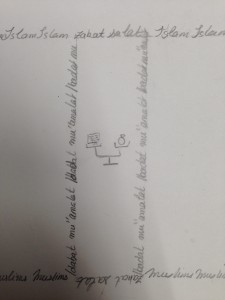
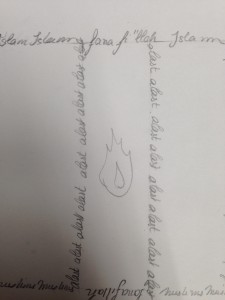
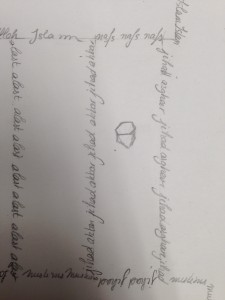
Reading: Infidel of Love: Exploring Muslim Understandings of Islam Chapter 2
This art project represents the “four prominent ideals” which according to professor Asani form the “core of [Muslims’] faith: peace and compassion, social justice, love of God and jihad”. I decided to form with important words associated with each of these 4 ideals the structure of a temple representing Muslims’ faith in Islam. The idea of the 5 pillars of Islam is a Sunni concept that has been associated with Islam in general. Yet, Muslim communities support different views on what the religious ideals and values of Islam should be. Professor Asani argues that they are 4 fundamental ideas that can be found among most Islamic branches. It inspired me to recreate a sort of Roman temple supported by 4 pillars. I chose for each of these pillars a symbol I though reflected the 4 values presented. I decided to draw a Roman temple instead of a Mosque as temples were a place dedicated to cult and religion but also because they have a symmetrical and usually simple architectural building. I wanted a building whose architecture could really reflect the idea I had of the structure of the Muslim Community, with elements pilling up, supporting each other towards the sky. Mosques can also have 4 towers on their sides but these structures are not supporting the entire edifice and thus do not fit my design as well as a Roman temple does.
The base of the building is the community that supports the entire religion: Muslims. Without a group that has some important values in common and that agrees on certain basic ideas and beliefs, a religion cannot exist. For Islam, the Muslims are the people who choose to follow this ideology.
The first pillar of the edifice of faith is peace and compassion according to professor Asani. He states in chapter 2 of his book that “Islam is literally a religion of peace and peace making”. The two most important phrases that marked me about this idea and that I used to build the first pillar were the “sirat al-mustaqim” and the words of the basmala “Bismi-llahi’r-Rahmani’r-Rahim”. The “path of peace” on which God is suppose to lead his rightful and pious followers and some names of God itself “In the Name of God, the Most Compassionate, the Most Merciful”. These two expressions express well the idea that Islam can be perceived and interpreted as a peaceful ideology and I chose to draw on that pillar the “sirat al-mustaqim”.
The second pillar is the one of Social Justice such as “helping the poor, the sick, and the marginalized. Professor Asani stated that Social Justice was itself supported by two different “sets of obligations”: the “idabat”, which is more of a divine obligation, a subjective one, (the belief that God’s message was transmitted to the Prophet) and the “mu’amalat” which is more of a social obligation towards society in general. These two notions express themselves in Muslims’ lives through the “salat” and the “zakat”. One cannot go without the other and this is why I chose as a symbol a balance; Muslims have to find the right equilibrium between salat and zakat.
The third pillar reflects the idea of a “selfless love of God”: the individual disappear, his egocentric desires and dreams evaporates as he gets closer and one with God, a point where he would be at the “fana fi’llah” (state of annihilation in God). The other important word is the “alast”, as moment in which “all of creation was united and contented in the Beloved’s presence”. I chose as a symbol a fire as the idea of getting purified of egocentric impulses and desires by fire has been a recursive theme in class.
The fourth and last pillar is the one about “jihad” which means ““to struggle, to toil, to exert great effort” but the exact definition and interpretation of the terms differ depending on economical, cultural and political variables. Thus, I choose as a symbol a diamond, as jihad can be observed through many different facets and reveal/mean completely different things. The lowest form of jihad is jihad asghar then the next one is jihad akbar but the greatest one is be the jihad against oneself: the “nafs”.
This art project tries to show that even though within a same communities of interpretation differ in their vision and practices of Islam, there still are some key concepts and values more or less shared among all Muslims.

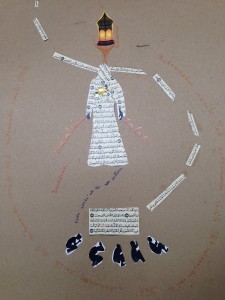


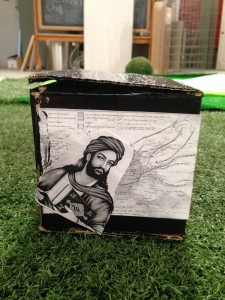
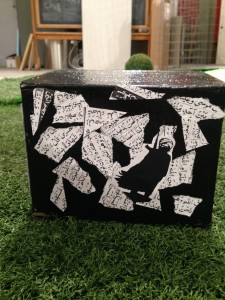

Recent Comments